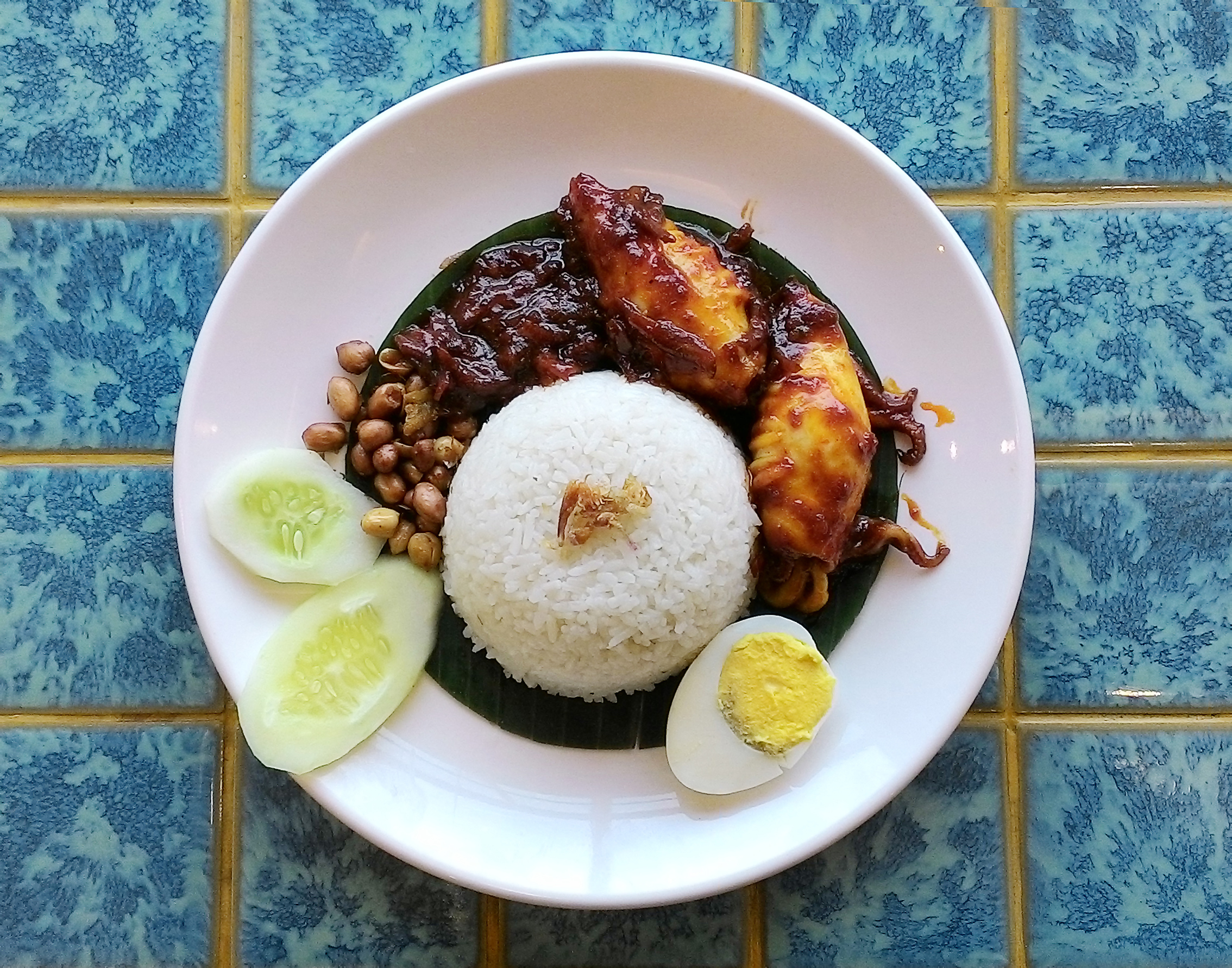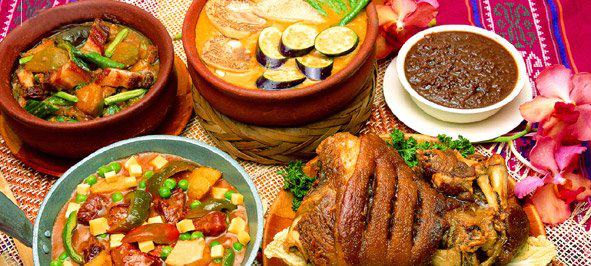|
Fusion Cuisine
Fusion cuisine is a cuisine that combines elements of different cuisine, culinary traditions that originate from different countries, regions, or cultures. Cuisines of this type are not categorized according to any one particular cuisine style and have played a part in many contemporary restaurant cuisines since the 1970s. The term fusion cuisine, added to the ''Oxford English Dictionary'' in 2002, is defined as "a style of cookery which blends ingredients and methods of preparation from different countries, regions, or ethnic groups; food cooked in this style." Categories Fusion food is created by combining various cooking techniques from different cultures to produce a new type of cuisine. Although it is commonly invented by chefs, fusion cuisine can occur naturally. Cuisines which get fused can either come from a particular region (such as East Asian cuisine and European cuisine), sub-region (such as Cuisine of the Southwestern United States, Southwestern American cuisine and ... [...More Info...] [...Related Items...] OR: [Wikipedia] [Google] [Baidu] |
Gobi Manchurian
Manchurian is a class of Indian Chinese cuisine, Indian Chinese dishes made by roughly chopping and deep-frying ingredients such as Chicken as food, chicken, cauliflower (''gobi''), Shrimp and prawn as food, prawns, Fish as food, fish, mutton, and paneer, and then sautéeing them in a sauce flavored with soy sauce. Manchurian is the result of the adaptation of Chinese cuisine, Chinese cooking and seasoning techniques, specifically aimed to suit Indian cuisine, Indian tastes. It has become a staple of Indian-Chinese cuisine; whilst largely unknown in China, it has become popular in India. History The word "Manchurian" means native or inhabitant of Manchuria (in northeast China); the dish, however, is a creation of Chinese restaurants in India, and bears little resemblance to traditional Manchu cuisine or Northeastern Chinese cuisine. It is said to have been invented in 1975 by Nelson Wang, a cook at the Cricket Club of India in Mumbai, when a customer asked him to create a new dis ... [...More Info...] [...Related Items...] OR: [Wikipedia] [Google] [Baidu] |
Mexican Cuisine
Mexican cuisine consists of the cuisines and associated traditions of the modern country of Mexico. Its earliest roots lie in Mesoamerican Cuisine, Mesoamerican cuisine. Mexican cuisine's ingredients and methods arise from the area's first agricultural communities, such as those of the Olmecs, Olmec and Maya civilization, Maya, who domesticated maize, created the standard process of nixtamalization, and established foodways. Successive waves of other Mesoamerican groups brought with them their cooking methods. These included the Teotihuacanos, Toltec, Huastec civilization, Huastec, Zapotec civilization, Zapotec, Mixtec, Otomi people, Otomi, Tarascan state, Purépecha, Totonac, Mazatec, Mazahua people, Mazahua, and Nahuas, Nahua. With the Mexica formation of the multi-ethnic Triple Alliance (Aztec Empire), culinary foodways became infused (Aztec cuisine). Today's food staples native to the land include corn (maize), turkey, beans, squash, amaranth, Chia seed, chia, avocados, to ... [...More Info...] [...Related Items...] OR: [Wikipedia] [Google] [Baidu] |
Javanese Cuisine
Javanese cuisine () is the cuisine of Javanese people, a major Native Indonesian, ethnic group in Indonesia in the provinces of Central Java, Yogyakarta, and East Java. Definition Javanese cuisine refers exclusively to the cuisine of Javanese people, which is often brought to other regions and countries by Javanese diaspora or foreign descents who have lived in Java. There are several native ethnic groups who live on the island of Java (Sundanese people, Sundanese, Madurese people, Madurese, Betawi people, Betawi, etc.) as well as other peoples of foreign descents. In Indonesian language, Javanese refers to people of Javanese ethnic background. Javanese cuisine is thought to be sweet, since this is the taste traditionally preferred in Yogyakarta. However, Javanese regions do not only include Yogyakarta. On the northern and northeastern of Central Java, for instance, the taste tends to be salty and spicy. In East Java, the level of spiciness increases. Today, as Javanese p ... [...More Info...] [...Related Items...] OR: [Wikipedia] [Google] [Baidu] |
Malay Cuisine
Malay cuisine (; Jawi script, Jawi: ) is the traditional food of the ethnic Malays of Southeast Asia, residing in modern-day Malaysia, Indonesia (parts of Sumatra and Kalimantan), Singapore, Brunei, Southern Thailand and the Philippines (mostly southern) as well as Cocos (Keeling) Islands, Cocos Islands, Christmas Island, Sri Lanka and South Africa. The main characteristic of traditional Malay cuisine is the generous use of spices. Coconut milk is also important in giving Malay dishes their rich, creamy character. The other foundation is ''belacan'' (prawn paste), which is used as a base for , a rich sauce or condiment made from , chili pepper, chilli peppers, onions and garlic. Malay cooking also makes plentiful use of lemongrass and galangal. Nearly every Malay meal is served with rice, which is also the staple food in many other Asian cultures. Although there are various types of dishes in a Malay meal, all are served at once, not in courses. A typical meal consists of a ... [...More Info...] [...Related Items...] OR: [Wikipedia] [Google] [Baidu] |
Indonesia
Indonesia, officially the Republic of Indonesia, is a country in Southeast Asia and Oceania, between the Indian Ocean, Indian and Pacific Ocean, Pacific oceans. Comprising over List of islands of Indonesia, 17,000 islands, including Sumatra, Java, Sulawesi, and parts of Borneo and New Guinea, Indonesia is the world's largest archipelagic state and the List of countries and dependencies by area, 14th-largest country by area, at . With over 280 million people, Indonesia is the world's List of countries and dependencies by population, fourth-most-populous country and the most populous Islam by country, Muslim-majority country. Java, the world's List of islands by population, most populous island, is home to more than half of the country's population. Indonesia operates as a Presidential system, presidential republic with an elected People's Consultative Assembly, legislature and consists of Provinces of Indonesia, 38 provinces, nine of which have Autonomous administrative divisi ... [...More Info...] [...Related Items...] OR: [Wikipedia] [Google] [Baidu] |
Malaysian Cuisine
Malaysian cuisine (Malay language, Malay: ''Masakan Malaysia''; Jawi script, Jawi: ) consists of cooking traditions and practices found in Malaysia, and reflects the multi-ethnic makeup of its population. The vast majority of Malaysia's population can roughly be divided among three major ethnic groups: Ethnic Malays, Malays, Chinese Malaysian, Chinese and Indian Malaysian, Indians. The remainder consists of the Dayak people, indigenous peoples of Sabah and Sarawak in East Malaysia, the Orang Asli of Peninsular Malaysia, the Peranakan and Eurasian creole communities, as well as a significant number of foreign workers and expatriates. As a result of historical migrations, colonisation by foreign powers, and its geographical position within its wider home region, Malaysia's culinary style in the present day is primarily a melange of traditions from its Malay, Chinese, Indian, Indonesian cuisine, Indonesian, Thai, Filipino cuisine, Filipino and indigenous Bornean and Orang Asli, w ... [...More Info...] [...Related Items...] OR: [Wikipedia] [Google] [Baidu] |
Filipino Cuisine
Filipino cuisine is composed of the cuisines of more than a hundred distinct Ethnic groups in the Philippines, ethnolinguistic groups found throughout the Philippines, Philippine archipelago. A majority of mainstream Filipino dishes that comprise Filipino cuisine are from the food traditions of various ethnolinguistic groups and tribes of the archipelago, including the Ilocano people, Ilocano, Pangasinan people, Pangasinan, Kapampangan people, Kapampangan, Tagalog people, Tagalog, Bicolano people, Bicolano, Visayan, Chavacano, and Maranao people, Maranao ethnolinguistic groups. The dishes associated with these groups evolved over the centuries from a largely indigenous (largely Austronesian peoples, Austronesian) base shared with maritime Southeast Asia with varied influences from Chinese cuisine, Chinese, Spanish cuisine, Spanish, and American cuisine, American cuisines, in line with the major waves of influence that had enriched the cultures of the archipelago, and adapted us ... [...More Info...] [...Related Items...] OR: [Wikipedia] [Google] [Baidu] |
Belgian Cuisine
Belgian cuisine is widely varied among regions, while also reflecting the cuisines of neighbouring France, Germany and the Netherlands. It is characterised by the combination of French cuisine with the more hearty Flemish fare. Outside the country, Belgium is best known for its chocolate, waffles, fries and beer. Though Belgium has many distinctive national dishes, many internationally popular foods like hamburgers and '' spaghetti bolognese'' are also popular in Belgium, and most of what Belgians eat is also eaten in neighbouring countries. "Belgian cuisine" therefore usually refers to dishes of Belgian origin, or those considered typically Belgian. Belgian cuisine traditionally prizes regional and seasonal ingredients. Ingredients typical in Belgian dishes include potatoes, leeks, grey shrimp, white asparagus, Belgian endive, horse meat and local beer, in addition to common European staples including meat, cheese and butter. Belgians typically eat four meals a day, with ... [...More Info...] [...Related Items...] OR: [Wikipedia] [Google] [Baidu] |
Jewish Cuisine
Jewish cuisine refers to the worldwide cooking traditions of the Jewish people. During its evolution over the course of many centuries, it has been shaped by Jewish dietary laws (''kashrut''), Jewish festivals and holidays, and traditions centred around Shabbat. Jewish cuisine is influenced by the economics, agriculture, and culinary traditions of the many countries where Jewish communities have settled and varies widely throughout the entire world. The history of Jewish cuisine begins with the cuisine of the ancient Israelites. As the Jewish diaspora grew, different styles of Jewish cooking developed. The distinctive styles in Jewish cuisine vary according to each community across the Ashkenazi, Sephardi, and Mizrahi diaspora groupings; there are also notable dishes within the culinary traditions of the standalone significant Jewish diaspora communities from Greece, Iran, and Yemen. Since the establishment of the State of Israel in 1948, and particularly since the late 19 ... [...More Info...] [...Related Items...] OR: [Wikipedia] [Google] [Baidu] |
Fish And Chips
Fish and chips is a hot dish consisting of batter (cooking), battered and fried fish, served with French fries, chips. Often considered the national dish of the United Kingdom, fish and chips originated in England in the 19th century. Today, the dish is a common Take-out, takeaway food in numerous other countries, particularly English-speaking and Commonwealth of Nations, Commonwealth nations. Fish and chip shops first appeared in the UK in the 1860s, and by 1910 there were over 25,000 of them across the UK. This increased to over 35,000 by the 1930s, but eventually decreased to approximately 10,000 by 2009. The British government safeguarded the supply of fish and chips during the First World War and again in the Second World War. It was one of the few foods in the UK Rationing in the United Kingdom, not subject to rationing during the wars, which further contributed to its popularity. History The British tradition of eating fish battered and fried in oil may have been i ... [...More Info...] [...Related Items...] OR: [Wikipedia] [Google] [Baidu] |
The World's 50 Best Restaurants
The World's 50 Best Restaurants is a list produced by the UK media company William Reed Ltd, William Reed, which originally appeared in the British magazine ''Restaurant (magazine), Restaurant'' in 2002. The list and awards are no longer directly related to ''Restaurant'', though they are owned by the same media company. In addition to the main 1–50 ranking, the organisation awards a series of special prizes for individuals and restaurants, including the One To Watch Award, the Icon Award, the Best Female Chef Award and the Chefs' Choice Award, the latter based on votes from the fifty head chefs from the restaurants on the previous year's list. In specific regions the organisation also pre-announces a 51–100 list, showcasing more venues in the area. Often working as a barometer of global gastronomic trends, the list showcases a variety of cuisines from all over the world. History The World’s 50 Best Restaurants list first appeared as a feature in the British magazine ... [...More Info...] [...Related Items...] OR: [Wikipedia] [Google] [Baidu] |






